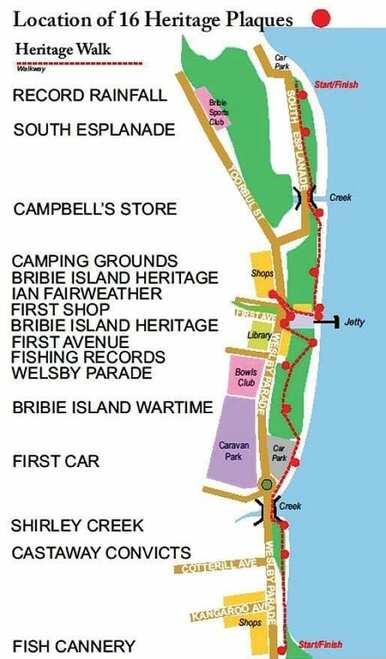Tags: History. Bribie island. Bongaree. Queensland. Australia
Take a Walking Tour Through Historic Bongaree
1. Record Rainfall. The greatest daily rainfall officially recorded anywhere in Australia fell near Pumicestone Passage on 3rd February 1893. After 3 weeks of continuous rain, a record total of 907mm was recorded at Beerwah by Inigo Jones, in this one 24 hour period.
2. South Esplanade. From the 1920s many large guest houses operated along here. Proprietors met the “excursion ships” and carried guests’ luggage over creeks and sand tracks, offering the attraction of speciality food and entertainment.
3. Campbell’s Store. In the 1890s Joe Campbell was an oysterman in the Passage. In the 1930s his son, Reg had a General Store & Boat Shed by this creek, when it was much larger and used as a boat harbour by campers and dugong fishermen.
4. Camping Grounds. In the 1920s there were few shops, no services, and less than 100 permanent residents. Many thousands came every week by ship from Brisbane and pitched their tents here to enjoy cheap and healthy holidays.
5. Bribie Island Heritage. “Bribie Island is one of the meanest pieces of country in Australia . . . a howling desert of tea-tree swamps rank aquatic vegetation and unimaginable cussedness”. Archibald Meston (1891) – Explorer, Author and Politician.
6. Ian Fairweather. After a lifetime of travel and adventure, in 1953 at the age of 62, this world-famous artist came to live in isolation in a grass hut inland from here. He created some of his finest paintings in this hut over the next 21 years until his death in 1974.
7. First Shop. A.H. “Artie” Bestmann kept bees and dairy cattle here from 1903. Alfred Hall, a Brisbane grocer, built a house next door in 1913 and together they provided basic goods to visitors from a spare room. In 1921 they built the “Hall and Bestmann Store: on this corner.
8. Bribie Island Heritage. “It might not be too much to claim, Pumicestone Passage and Bribie Island contain more history, written and unwritten, than any other place in Queensland”. Stan Tutt (1981) – Sunshine Coast Historian.
9. First Avenue. Originally named Campbell Rd., for the Director of the Tug Company who had the road built from Bongaree to Woorim in 1923. It was planned to be a four-lane road and steam tramway but this did not eventuate although initially, it was a toll road.
10. Fishing Records. “Bribie Jetty and its environs must be the most remarkable fishing place in Australia. More black groper have been caught here than any other spot in Australia. A man known as the “Groper King” caught many over 500 lbs”. Ted Shields (1947) – Fisherman and Barge Owner.
11. Welsby Parade. This road named for Thomas Welsby, Brisbane historian, sportsman and author, who in 1937 at the age of 80, wrote the book “Bribie the Basket Maker” and thus created a legend about the Island and its name.
12. Bribie Island Wartime. Bribie Island and Toorbul Point (now Sandstone Point) were major training based for Navy and Army Forces during World War 2. Many military structures are still visible along the Ocean Beach and a small arms store can be seen across the road.
13. First Car. In 1918 A.H. “Artie” Bestmann drove the first car, a 1914 Talbot, to Bongaree, with a young Ian Hall as his passenger. They did the 2-day drive from Brisbane along beach and bush tracks, and then by barge from Godwin Beach across the Passage.
14. Shirley Creek. Bill Shirley built the first road from the Jetty to Ocean Beach in 1923. He ran a bus service and a guest house and became Bribie’s First Councillor. A Wooden Bridge replaced a single plank walkway here in 1935 as his first council works.
15. Castaway Convicts. In 1823 three Sydney convicts in a small boat were caught in a huge storm which dumped them close to death on Moreton Island. They walked around Moreton Bay, thinking Sydney was nearby and were the first white men to live on Bribie Island, being there for many months before recapture.
16. Fish Cannery. A fish canning factory operated near here from 1910 to 1914 owned by Mrs Sarah “Mum” Balls. She also had many hotels and refreshment rooms in Queensland and in 1929 built “Santa Barbara”, one of Brisbane’s grandest homes.
https://sites.google.com/site/bribiehistoricalsociety/ Bribie Island Historical Society Inc. – Heritage Plaques – Information Leaflet 2014
Other Articles
https://thebribieislander.com.au/historical-women-bribie-island/
https://thebribieislander.com.au/bribie-island-history/
